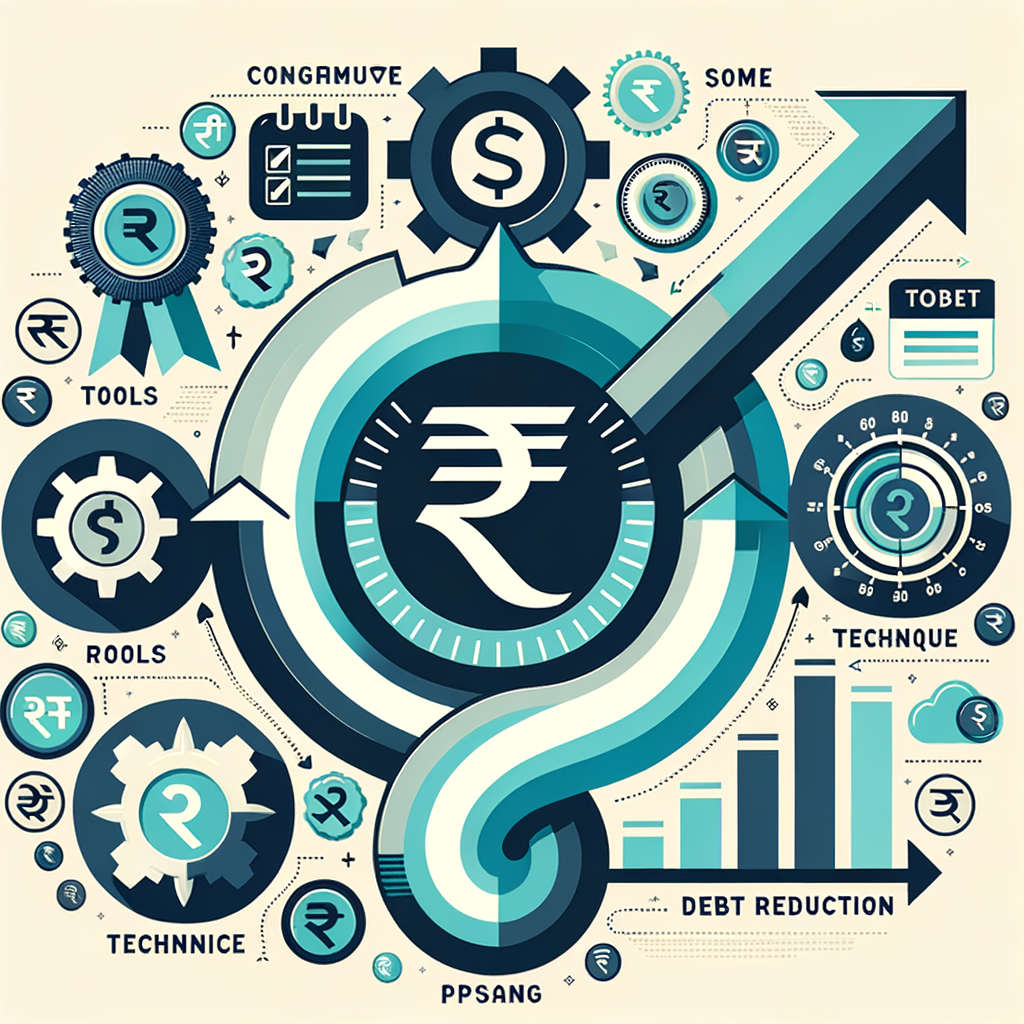Tracking Your Debt Repayment Progress: Tools and Techniques
Juggling multiple EMIs from a business loan, a home loan, and mounting credit card bills can feel like an overwhelming financial puzzle. You diligently make payments every month, but does it ever feel like you aren’t making any real progress toward your goal? Without a clear system, it’s easy to lose motivation, miss payments, or fail to see the light at the end of the tunnel. This lack of clarity is where effective debt repayment progress tracking becomes your most powerful financial tool. It’s the key to gaining control, staying motivated, and strategically clearing what you owe. This comprehensive guide will walk you through simple yet powerful tools and techniques to monitor your journey to becoming debt-free in India.
Why is Debt Repayment Progress Tracking Crucial?
Tracking your debt is about much more than just watching numbers on a screen; it’s about building a robust financial strategy that empowers you. For small business owners and salaried individuals in India, understanding the fine details of your liabilities is the first step toward financial independence. It transforms a daunting task into a manageable project with a clear finish line. By actively monitoring your progress, you shift from being a passive payer to an active manager of your own financial destiny, enabling you to make smarter decisions that accelerate your path to a debt-free life.
Provides Motivation and a Sense of Accomplishment
The psychological aspect of debt repayment cannot be overstated. When you’re facing a large outstanding balance, it can feel like your monthly payments are just a drop in the ocean. However, when you visually track your progress—perhaps with a chart or a simple ledger—you get a tangible reward for your discipline. Seeing the principal amount decrease, even by a small margin each month, provides a powerful psychological boost. This visual confirmation of your hard work acts as a continuous motivator, reinforcing positive financial habits and encouraging you to stick with your plan, especially during months when finances feel tight.
Enables Better Financial Planning and Budgeting
Effective debt repayment progress tracking offers a crystal-clear view of where your money is going each month. When you have a consolidated list of all your debts, their interest rates, and EMIs, you can analyze your cash flow with precision. This clarity is essential for both individuals and small business owners to create a realistic and effective budget. For business owners specifically, this is a core component of A Guide to Budgeting and Financial Planning for Startups. It helps you identify potential areas to cut back on spending, freeing up extra funds that can be used to make prepayments on high-interest loans. This proactive approach not only helps you get out of debt faster but also builds a strong foundation for future financial goals, like investing or saving for a major purchase.
Helps in Choosing the Right Repayment Strategy
Not all repayment methods are created equal, and the best one for you depends on your financial situation and personality. Consistently tracking your debts provides the data you need to choose between popular debt repayment strategies in India, often starting with the Debt Snowball vs. Debt Avalanche: Which Strategy Is Best for You? decision. For instance, you might opt for the Debt Snowball method, where you focus on paying off the smallest loans first to gain motivational wins. Alternatively, you could choose the Debt Avalanche method, which prioritizes clearing loans with the highest interest rates to save money in the long run. Without a clear tracking system, it’s nearly impossible to effectively implement and stick to these powerful strategies.
Improves Your CIBIL Score Over Time
Your CIBIL score is one of your most valuable financial assets in India, influencing your ability to secure future loans at favourable interest rates. Knowing How to Track Your Credit History Using Your PAN Card Via CIBIL can give you a significant advantage. The most significant factor affecting this score is your payment history. A meticulous debt tracking system acts as your personal financial assistant, minimizing the risk of missed or late payments. By setting up reminders and having a clear view of all your due dates, you ensure every EMI is paid on time. This consistent, disciplined repayment behaviour is reported to credit bureaus and directly contributes to a healthier credit profile and an improved CIBIL score over time.
Actionable Tip: You can check your official CIBIL score and report by visiting the official CIBIL website or using authorized platforms to monitor your credit health regularly.
Manual Techniques for Tracking Debt Repayment Progress
For those who prefer a hands-on, simple approach without relying on technology, manual tracking methods are an excellent starting point. These techniques give you a granular understanding of your financial situation and can be customized to your exact needs. While they require more discipline, they are powerful techniques to track debt repayment progress and build strong financial habits from the ground up.
The Classic Pen-and-Paper Method
The simplest way to start tracking is with a dedicated notebook or ledger. This tangible method can be very satisfying, as you physically cross off payments and see your balances shrink. To create your debt repayment ledger, dedicate a page to each loan or credit card and create columns to track essential information.
- Columns to include:
- Name of Lender: For example, HDFC Bank Home Loan, Bajaj Finserv Personal Loan.
- Total Loan Amount: The original principal amount you borrowed.
- Interest Rate: The annual percentage rate (APR) of the loan.
- Monthly EMI: The fixed amount you pay each month.
- Payment Date: The date each month the payment is due or made.
- Remaining Balance After Payment: The new outstanding amount after your EMI is deducted.
Each month, after making your payment, you simply add a new entry and calculate the new remaining balance. This keeps you constantly engaged with your progress.
Using Spreadsheets (Google Sheets or MS Excel)
Using a spreadsheet is a more dynamic, organized, and efficient evolution of the pen-and-paper method. For many, it’s the most effective answer to the question of how to track debt repayment in India without using a paid app. Platforms like Google Sheets (free) or Microsoft Excel offer powerful features to automate calculations and visualize your progress, saving you time and reducing the risk of manual errors.
- Steps to Create a Tracker:
- List All Debts: Open a new sheet and list all your debts in separate rows. Include the lender’s name and the type of loan (e.g., Car Loan, Credit Card Debt).
- Create Essential Columns: Create columns for: Loan Name, Total Principal, Interest Rate, EMI Amount, Payment Due Date, and a running Outstanding Balance.
- Use Simple Formulas: In the ‘Outstanding Balance’ column, you can use a simple subtraction formula. For instance, if your previous balance is in cell F2 and your EMI principal component is in cell G2, the new balance would be
=F2-G2. This automatically updates your progress. - Visualize Your Progress: Use the charting feature to create a pie chart showing your debt distribution or a line graph illustrating how your total outstanding balance is decreasing over time. This visual feedback is incredibly motivating.
Actionable Tip: To get started immediately, you can use a pre-made template. Downloadable Debt Tracker Template from TaxRobo to kickstart your journey.
Top Debt Repayment Tracking Tools for India
For those who prefer automated, tech-driven solutions, the Indian market offers a variety of powerful applications and platforms. These debt repayment tracking tools India provides can sync with your accounts, send reminders, and offer a consolidated view of your finances with minimal manual effort. These debt management tools for Indians are designed to simplify your financial life.
Dedicated Budgeting & Expense Tracking Apps
Many popular financial apps in India come with robust features for loan and credit card management. These debt repayment apps for Indian users are designed to provide a holistic view of your financial health.
- INDmoney: This app is a powerhouse for financial tracking. It securely syncs with your email and bank accounts to automatically detect and track your loans, EMIs, and credit card dues. It provides a single dashboard view of all your liabilities, helping you monitor outstanding balances and payment schedules effortlessly.
- Walnut (by Capital Float): Walnut excels at expense tracking and bill reminders. It automatically scans your SMS inbox for transaction details, categorizes your spending, and reminds you of upcoming bill and EMI due dates. This feature is invaluable for ensuring you never miss a payment.
- Money Manager Expense & Budget: While it often requires manual entry, this app offers deep customization for tracking loans. You can input your loan details, including principal and interest, and log payments against them. Its detailed reporting features allow you to see exactly where your money is going and how your debt is being paid down.
Your Bank’s Mobile App and Net Banking Portal
Often, the most straightforward tool is the one provided directly by your lender. Every major bank in India, such as SBI (YONO App), HDFC Bank (HDFC Bank App), and ICICI Bank (iMobile Pay), offers detailed information within its digital platforms.
- How to Use: Log in to your bank’s mobile app or net banking portal and navigate to the ‘Loan Accounts’ or ‘Loan Details’ section. Here, you can access your loan account statement, which breaks down each EMI into its principal and interest components. This statement is the official record of your
tracking personal debt repayment progressand shows you the exact outstanding principal after every payment.
Consolidated Credit Reporting Platforms
Platforms that provide your credit score often double as excellent debt tracking tools. Services like OneScore or CRIF offer a free credit score check and provide a consolidated view of all your active loans and credit cards as reported by lenders to the credit bureaus. This allows you to see all your liabilities in one place, ensuring you haven’t forgotten any old accounts and can monitor your overall credit exposure.
A Step-by-Step Guide to Start Tracking Your Debt Today
Ready to take control? Following this simple, actionable checklist will help you start tracking personal debt repayment progress effectively from day one.
Step 1: Consolidate All Your Debt Information
The first step is to get organized. Gather all your financial documents, including loan agreements, credit card statements, and any other relevant paperwork. Create a master list that includes the following for each debt:
- Name of the Lender
- Current Outstanding Principal
- Annual Interest Rate
- Fixed Monthly EMI Amount and Due Date
Step 2: Choose Your Tracking Method
Based on your personal preference and comfort with technology, decide which method you’ll use. Will you go with a manual pen-and-paper ledger, a dynamic spreadsheet, or one of the automated Indian tools for debt progress tracking like INDmoney? The best tool is the one you will consistently use.
Step 3: Select a Repayment Strategy
Now, decide on your plan of attack. Using the information you gathered, select a repayment strategy that aligns with your financial goals and personality.
| Strategy | How It Works | Best For |
|---|---|---|
| Debt Snowball | Make minimum payments on all debts, but put any extra money toward the debt with the smallest balance first. Once it’s paid off, roll that payment amount into the next smallest debt. | Individuals who need quick, motivational wins to stay on track. |
| Debt Avalanche | Make minimum payments on all debts, but put any extra money toward the debt with the highest interest rate first. Once it’s paid off, roll that payment amount into the debt with the next highest interest rate. | Individuals who are disciplined and want to save the most money on interest over the long term. |
Step 4: Set Up Your Tracker and Update It Religiously
Populate your chosen tool—be it a spreadsheet or an app—with all the information from Step 1. The final, and most crucial, step is to be consistent. Make it a habit to update your tracker every single time you make a payment. Consistency is the cornerstone of successful debt repayment progress tracking and will keep you focused and accountable on your journey to financial freedom.
Conclusion
Mastering your finances begins with understanding them. From the psychological boost of seeing your balances shrink to making strategic decisions that save you money, the benefits of tracking your debt are immense. Whether you choose a simple notebook, a powerful spreadsheet, or a modern app, the key is to start now and stay consistent. Consistent debt repayment progress tracking is not just about managing what you owe—it’s the most reliable path toward achieving financial freedom for you and your business, allowing you to build a more secure and prosperous future.
Call to Action (CTA): While you focus on clearing your debts, let TaxRobo handle your financial and legal compliance. From GST filing and accounting to company registration, our experts can help you stay organized and compliant. Contact us today for a free consultation!
Frequently Asked Questions (FAQs)
1. What is the best way to track multiple loans and credit card debts in India?
A well-organized spreadsheet (like Google Sheets) or a dedicated aggregator app like INDmoney is ideal for managing multiple liabilities. These tools allow you to see all your debts in one consolidated dashboard. This centralized view makes it much easier to manage payments, compare interest rates, and track your overall progress without having to log in to multiple banking apps.
2. How often should I update my debt repayment tracker?
At a minimum, you should update your tracker once a month, right after all your scheduled EMIs and bill payments have been processed. This gives you an accurate month-end snapshot of your progress. However, for more active management, especially if you are making extra prepayments or following a specific strategy like the Debt Snowball, updating it weekly or after each payment can provide greater clarity and motivation.
3. Can tracking my debt repayment really improve my CIBIL score?
Yes, it can, albeit indirectly. The single most important factor for a high CIBIL score is a flawless on-time payment history. A good tracking system acts as a safety net, ensuring you are aware of all due dates and make all your payments on time. By systematically avoiding late fees and defaults—which are major negative events for your credit report—you are actively building a positive credit history and improving your score over time.
4. Are there any completely free debt repayment tracking tools India offers?
Absolutely. Using a spreadsheet like Google Sheets (which only requires a free Google account) or Microsoft Excel (available with a free Microsoft account online) is 100% free and highly effective. Additionally, your bank’s mobile app and net banking portal provide loan statements and details at no cost. Many popular fintech apps, such as Walnut, also offer free versions with more than enough features for basic expense and debt tracking.



